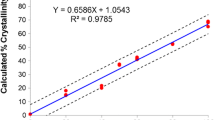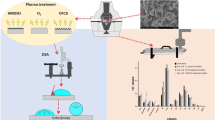Abstract
The objective of this study was to investigate the effect of particle surface coating with magnesium stearate on the aerosolization of dry powder inhaler formulations. Micronized salbutamol sulphate as a model drug was dry coated with magnesium stearate using a mechanofusion technique. The coating quality was characterized by X-ray photoelectron spectroscopy. Powder bulk and flow properties were assessed by bulk densities and shear cell measurements. The aerosol performance was studied by laser diffraction and supported by a twin-stage impinger. High degrees of coating coverage were achieved after mechanofusion, as measured by X-ray photoelectron spectroscopy. Concomitant significant increases occurred in powder bulk densities and in aerosol performance after coating. The apparent optimum performance corresponded with using 2% w/w magnesium stearate. In contrast, traditional blending resulted in no significant changes in either bulk or aerosolization behaviour compared to the untreated sample. It is believed that conventional low-shear blending provides insufficient energy levels to expose host micronized particle surfaces from agglomerates and to distribute guest coating material effectively for coating. A simple ultra-high-shear mechanical dry powder coating step was shown as highly effective in producing ultra-thin coatings on micronized powders and to substantially improve the powder aerosolization efficiency.


Similar content being viewed by others
REFERENCES
Timsina MP, Martin GP, Marriott C, Ganderton D, Yianneskis M. Drug-delivery to the respiratory-tract using dry powder inhalers. Int J Pharm. 1994;101(1–2):1–13.
Chan HK, Chew NYK. Novel alternative methods for the delivery of drugs for the treatment of asthma. Adv Drug Deliv Rev. 2003;55(7):793–805.
Patton JS, Platz RM. Penetration enhancement for polypeptides through epithelia. D. Routes of delivery—case-studies. 2. Pulmonary delivery of peptides and proteins for systemic action. Adv Drug Deliv Rev. 1992;8(2–3):179–96.
Kretchme N, Faber HK. Lactose intolerance. Nutr Rev. 1972;30(11):260.
Najafabadi AR, Gilani K, Barghi M, Rafiee-Tehrani M. The effect of vehicle on physical properties and aerosolisation behaviour of disodium cromoglycate microparticles spray dried alone or with L-leucine. Int J Pharm. 2004;285(1–2):97–108.
Rabbani NR, Seville PC. The influence of formulation components on the aerosolisation properties of spray-dried powders. J Control Release. 2005;110(1):130–40.
Raula J, Laehde A, Kauppinen EI. A novel gas phase method for the combined synthesis and coating of pharmaceutical particles. Pharm Res. 2008;25(1):242–5.
Chew NYK, Shekunov BY, Tong HHY, Chow AHL, Savage C, Wu J, et al. Effect of amino acids on the dispersion of disodium cromoglycate powders. J Pharm Sci. 2005;94(10):2289–300.
Sou T, Orlando L, McIntosh MP, Kaminskas LM, Morton DAV. Investigating the interactions of amino acid components on a mannitol-based spray-dried powder formulation for pulmonary delivery: a design of experiment approach. Int J Pharm. 2011;421(2):220–9.
Pilcer G, Sebti T, Amighi K. Formulation and characterization of lipid-coated tobramycin particles for dry powder inhalation. Pharm Res. 2006;23(5):931–40.
Chew NYK, Chan HK. Use of solid corrugated particles to enhance powder aerosol performance. Pharm Res. 2001;18(11):1570–7.
Adi H, Traini D, Chan HK, Young PM. The influence of drug morphology on the aerosolisation efficiency of dry powder inhaler formulations. J Pharm Sci. 2008;97(7):2780–8.
Chow AHL, Tong HHY, Chattopadhyay P, Shekunov BY. Particle engineering for pulmonary drug delivery. Pharm Res. 2007;24(3):411–37.
Pfeffer R, Dave RN, Wei D, Ramlakhan M. Synthesis of engineered particulates with tailored properties using dry particle coating. Powder Technol. 2001;117(1–2):40–67.
Bose S, Bogner RH. Solventless pharmaceutical coating processes: a review. Pharm Dev Technol. 2007;12(2):115–31.
Zhou Q, Morton DAV. Drug-lactose binding aspects in adhesive mixtures: controlling performance in dry powder inhaler formulations by altering lactose carrier surfaces. Adv Drug Deliv Rev. 2012;64(3):275–84.
Zhou QT, Armstrong B, Larson I, Stewart PJ, Morton DAV. Understanding the influence of powder flowability, fluidization and de-agglomeration characteristics on the aerosolization of pharmaceutical model powders. Eur J Pharm Sci. 2010;40(5):412–21.
Rowe RC, Sheskey PJ, Quinn ME. Handbook of pharmaceutical excipients. 6th ed. London: Pharmaceutical Press; 2009. p. 434.
Pilcer G, Amighi K. Formulation strategy and use of excipients in pulmonary drug delivery. Int J Pharm. 2010;392(1–2):1–19. doi:10.1016/j.ijpharm.2010.03.017.
Zhou QT, Qu L, Larson I, Stewart PJ, Morton DAV. Improving aerosolization of drug powders by reducing powder intrinsic cohesion via a mechanical dry coating approach. Int J Pharm. 2010;394(1–2):50–9.
Zhou QT, Armstrong B, Larson I, Stewart PJ, Morton DAV. Improving powder flow properties of a cohesive lactose monohydrate powder by intensive mechanical dry coating. J Pharm Sci. 2010;99(2):969–81. doi:10.1002/jps.21885.
Zhou QT, Denman JA, Gengenbach T, Das S, Qu L, Zhang H, et al. Characterization of the surface properties of a model pharmaceutical fine powder modified with a pharmaceutical lubricant to improve flow via a mechanical dry coating approach. J Pharm Sci. 2011;100(8):3421–30.
Schwedes J. Review on tester for measuring flow properties of bulk solids. Granul Matter. 2001;5:1–43.
Marriott C, MacRitchie HB, Zeng XM, Martin GP. Development of a laser diffraction method for the determination of the particle size of aerosolised powder formulations. Int J Pharm. 2006;326(1–2):39–49.
Srichana T, Martin GP, Marriott C. A human oral-throat cast integrated with a twin-stage impinger for evaluation of dry powder inhalers. J Pharm Pharmacol. 2000;52(7):771–8. doi:10.1211/0022357001774624.
Miller TA, York P. Pharmaceutical tablet lubrication. Int J Pharm. 1988;41(1–2):1–19.
Kippax P, Morton DAV. Aerosolization analysis. Drug Deliv Technol. 2008;8(1):53–8.
Coates MS, Fletcher DF, Chan HK, Raper JA. The role of capsule on the performance of a dry powder inhaler using computational and experimental analyses. Pharm Res. 2005;22(6):923–32.
Castellanos A. The relationship between attractive interparticle forces and bulk behaviour in dry and uncharged fine powders. Adv Phys. 2005;54(4):263–376.
Edwards DA, Hanes J, Caponetti G, Hrkach J, BenJebria A, Eskew ML, et al. Large porous particles for pulmonary drug delivery. Science. 1997;276(5320):1868–71. doi:10.1126/science.276.5320.1868.
Ikegami K, Kawashima Y, Takeuchi H, Yamamoto H, Mimura K, Mamose D, et al. A new agglomerated KSR-592 beta-form crystal system for dry powder inhalation formulation to improve inhalation performance in vitro and in vivo. J Control Release. 2003;88(1):23–33. doi:10.1016/s0168-3659(02)00460-1.
Telko MJ, Hickey AJ. Dry powder inhaler formulation. Respir Care. 2005;50(9):1209–27.
Zhou QT, Qu L, Gengenbach T, Denman JA, Larson I, Stewart PJ, et al. Investigation of the extent of surface coating via mechanofusion with varying additive levels and the influences on bulk powder flow properties. Int J Pharm. 2011;413(1–2):36–43.
Iida K, Hayakawa Y, Okamoto H, Danjo K, Luenberger H. Effect of surface layering time of lactose carrier particles on dry powder inhalation properties of salbutamol sulfate. Chem Pharm Bull. 2004;52(3):350–3. doi:10.1248/cpb.52.350.
Young PM, Cocconi D, Colombo P, Bettini R, Price R, Steele DF, et al. Characterization of a surface modified dry powder inhalation carrier prepared by “particle smoothing”. J Pharm Pharmacol. 2002;54(10):1339–44. doi:10.1211/002235702760345400.
ACKNOWLEDGMENTS
Qi (Tony) Zhou acknowledges the financial support of Postgraduate Publications Award from Monash University. Miat S.p.A and Capsugel Australia are acknowledged for kind donations of Monodose inhalers and HPMC capsules, respectively.
Author information
Authors and Affiliations
Corresponding authors
Rights and permissions
About this article
Cite this article
Zhou, Q.(., Qu, L., Gengenbach, T. et al. Effect of Surface Coating with Magnesium Stearate via Mechanical Dry Powder Coating Approach on the Aerosol Performance of Micronized Drug Powders from Dry Powder Inhalers. AAPS PharmSciTech 14, 38–44 (2013). https://doi.org/10.1208/s12249-012-9895-z
Received:
Accepted:
Published:
Issue Date:
DOI: https://doi.org/10.1208/s12249-012-9895-z




